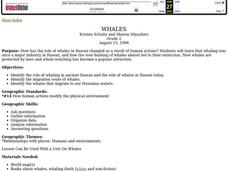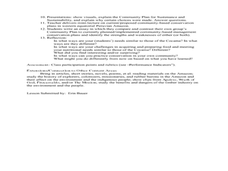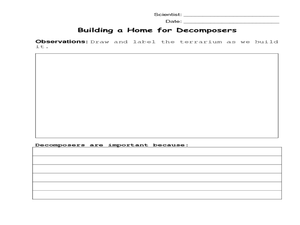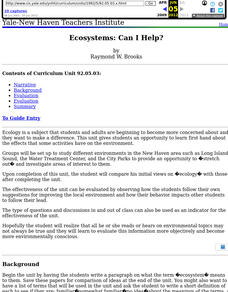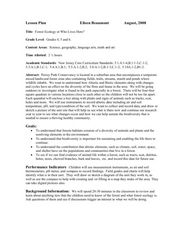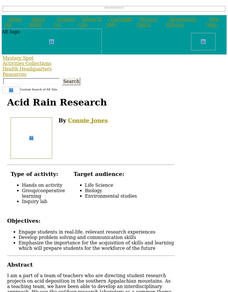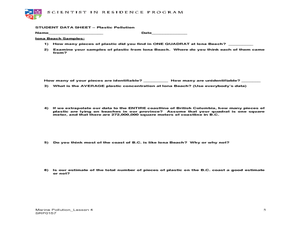Curated OER
Whales
Second graders identify the role of whaling in ancient Hawaii and the role of whales in Hawaii today, identify the migration route of whales and identify the whales that migrate to our Hawaiian waters.
Curated OER
Waste Management
Students explore the impact on waste on the environment, and the impact of the 3R's (reduce, reuse and recycle) as a means of diminishing the waste created by humans.
Curated OER
Positively Paper
Students discover how paper is recycled. In this recycling lesson, students investigate which types of paper recycle best and are best for the environment.
Curated OER
Studying Exothermic and Endothermic Reactions
Students explore the mesosphere and lower thermosphere globally and achieve a major improvement in our understanding of the fundamental processes governing the energetics, chemistry, dynamics, and transport of the atmospheric region....
Curated OER
Supermarkets, Sustenance and Sustainability
Students investigate jungles and the people who depend upon them. In this sustainability lesson, students research wild life conservation and discover the importance of a jungle to Amazonian people. Students create a group...
Curated OER
Groundwater Basics
High schoolers explore the volume of groundwater using math problems. They compute mathematical problems to figure the volume of groundwater and calculate the average porosity in an aquifer. Students estimate the amount of water needed...
Curated OER
I Don't Think We're in Kansas Anymore (Grades 2-5)
Students give examples of erosion and weathering processes. They determine causes of America's Dust Bowl phenomena.Students define erosion as the condition in which the earth's surface is worn away by the action of water and wind.
Curated OER
Non-Point Source Pollution
Learners study non-point source pollution. They research the concept of bio-degradation and/or Nutrients/Fertilizers and discuss how non-point source pollution impacts the environment. Afterwards, they participate in an interactive...
Curated OER
Animals: Worms
Learners research the physical characteristics of mealworms and tubefex. In this worm lesson plan, students explore worms using a microscope. Learners search their environment for worms.
Curated OER
Acid Rain and pH
Students study acidic and alkaline balance. In this acid and pH levels lesson, students read information about pH, the formation of acid rain and its impact on environments. Students then complete an experiment to learn about the...
Curated OER
De-composers - Terrarium
Learners explore the environment by building a mock ecosystem. In this rainforest analysis lesson, students define many environmental and rainforest related vocabulary terms and discuss the current status of our planet's rainforests....
Curated OER
Ecosystems: Can I Help?
Students study how some activities effect the environment and ecosystems.
Curated OER
Nutrition Lesson Plans That Promote Healthy Habits
Students can learn about good nutrition, and the environment through these inspiring health lesson plans
Curated OER
INFORMATION FLUENCY UNIT
Seventh graders, after defining/brainstorm the task, divide up into groups and are assigned to an alternative energy source (wind, solar, or water) to research. They complete a presentation with visuals on their findings from their...
Curated OER
Earth Day - Grow A Seed Garden
Students discover how things grow and how they can take better care of the environment in this Earth Day lesson for the elementary classroom. The activity can be accomplished in one day and left in the sun until the "beans" begin growing.
Curated OER
Animals
First graders study the basic needs of animals and compare them to human needs. They make bird feeders using milk carton and pine cones. They review the basic needs of food, water, air, and shelter and discuss what happens when animals...
Curated OER
What are Properties of Wood?
Students use hands on scientific observation to determine characteristics of wood. They work directly with the materials and record their observations. Students test if wood absorbs water, if wood floats or sinks, and if all wood...
Curated OER
Erosion Explosion
Ninth graders explore soil erosion. Through a class discussion, they examine soil conservation methods. Given a potted plant, 9th graders observe the effects of erosion when water is poured over the soil. Students brainstorm terms...
Curated OER
Let it Grow!
Students explain the relationship of plants and animals in the environment. They name the basic requirements for plant growth and define the terms photosynthesis, stomata, chlorophyll and xylem.
Curated OER
Outdoor Activities/Problem Solving: Play a Listening Game
Students listen to everyday sounds that help them develop listening skills. In this early childhood lesson plan, students develop listening and language skills to recreate sounds in the outdoor environment.
Curated OER
Forest Ecology or Who Lives Here?
Students explore a hardwood forest. In this forest ecology lesson, students examine the diversity and animals and plants as they explore their habitats at Poricy Park Conservatory. Students determine how biodiversity and abiotic elements...
Curated OER
Acid Rain Research
Students collect samples of rainfall, cloud condensation, and water that trickles through the soil. These samples are tested for pH, conductivity, and the presence of sulfates, nitrates, calcium, and magnesium.
Curated OER
Time and Cycles - Dendrochronology
Students investigate the lives of trees by examining ring cycles. In this plant life lesson, students identify the field of study known as dendrochronology and discover its history. Students investigate a simulated tree ring...
Curated OER
Plastic Pollution
Young scholars determine with math concepts how much plastic pollution is affecting marine life. In this plastic pollution lesson plan, students collect scientific data from a field trip to a water treatment plant.
